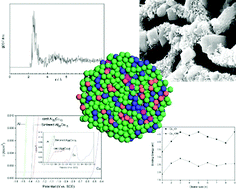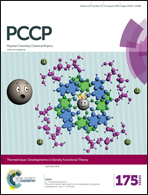Nanostructured copper/copper oxide hybrids: combined experimental and theoretical studies†
Abstract
With the extensive study of dealloying, copper oxides have been shown to be important members and exhibit huge potential in catalysis, energy transformation and storage fields. In this work, nanostructured copper/copper oxide hybrids were prepared through dealloying the sintered Al85Cu15 alloy and molecular dynamics (MD) simulations as well as calculations based on density functional theory (DFT) were performed to explore the oxidation mechanisms of copper in aqueous electrolytes. Cu/Cu2O/CuO compositions were obtained after immersing the sintered alloys in 20 wt% NaOH solutions under corrosion-free conditions at room temperature. Both X-ray diffraction (XRD) and potentiodynamic polarization results reveal that there exist large differences between the sintered Al85Cu15 alloy and its counterpart cast alloy and the Rietveld simulation analysis as well as MD simulations testify to the inhomogeneous atom distribution in the sintered alloy. DFT studies show that Cun (1 ≤ n ≤ 9) clusters possess higher surface energies than the Cu(111) surface and the calculated binding energies of the copper clusters and an atomic oxygen (Cun–O) are much higher than that of Cu(111)–O. The low surface diffusivity (Ds) of the clusters at the alloy–electrolyte interface extends their diffusion time, which may be beneficial to the formation and growth of oxide nuclei precursors during the dealloying process. Their microstructures and morphologies characterized by scanning electron microscopy (SEM) and transmission electron microscopy (TEM) show that CuO exists in the form of a nanoplate while Cu2O is a nanoparticle. Nanoporous copper (NPC) obtained by dealloying sintered and cast alloys exists in the form of a bicontinuous ligament–channel structure. This work enriches the dealloying research from both experimental and theoretical aspects.


 Please wait while we load your content...
Please wait while we load your content...